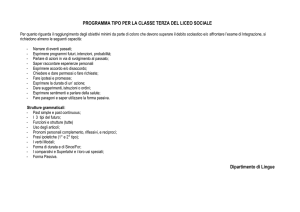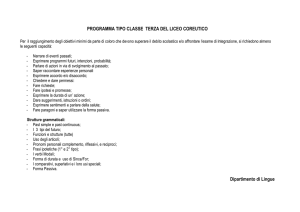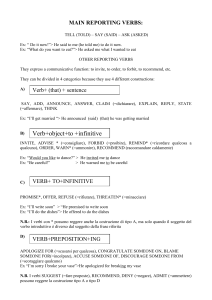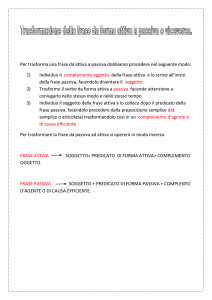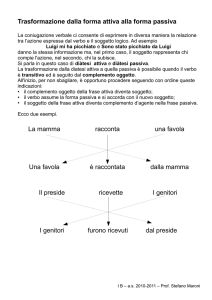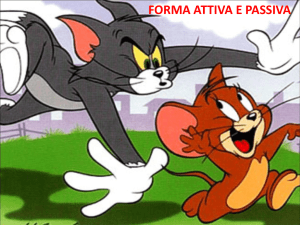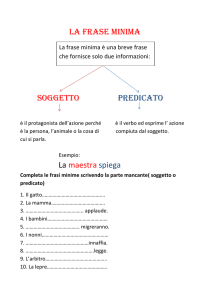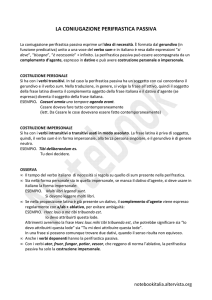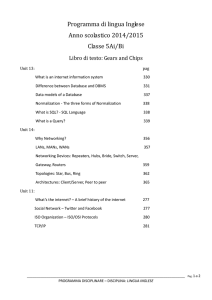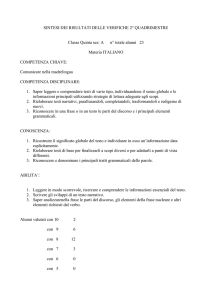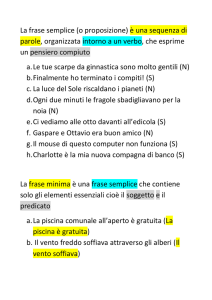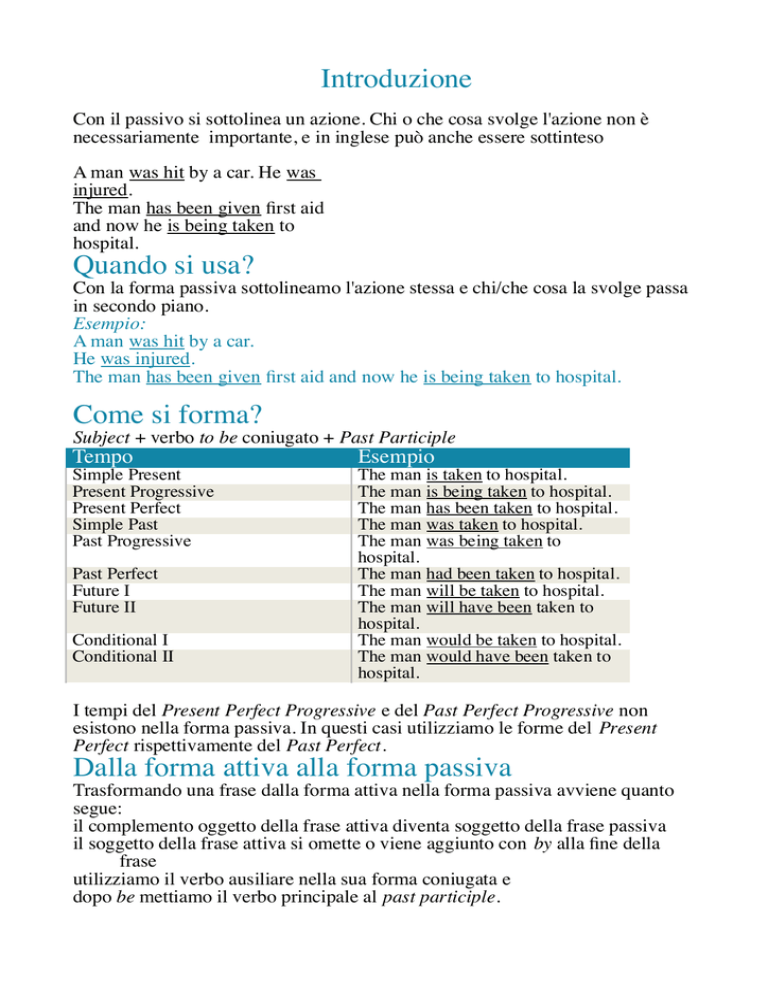
Il Introduzione
Con il passivo si sottolinea un azione. Chi o che cosa svolge l'azione non è
necessariamente importante, e in inglese può anche essere sottinteso
A man was hit by a car. He was
injured.
The man has been given first aid
and now he is being taken to
hospital.
Quando si usa?
Con la forma passiva sottolineamo l'azione stessa e chi/che cosa la svolge passa
in secondo piano.
Esempio:
A man was hit by a car.
He was injured.
The man has been given first aid and now he is being taken to hospital.
Come si forma?
Subject + verbo to be coniugato + Past Participle
Tempo
Simple Present
Present Progressive
Present Perfect
Simple Past
Past Progressive
Past Perfect
Future I
Future II
Conditional I
Conditional II
Esempio
The man is taken to hospital.
The man is being taken to hospital.
The man has been taken to hospital.
The man was taken to hospital.
The man was being taken to
hospital.
The man had been taken to hospital.
The man will be taken to hospital.
The man will have been taken to
hospital.
The man would be taken to hospital.
The man would have been taken to
hospital.
Nota
I tempi del Present Perfect Progressive e del Past Perfect Progressive non
esistono nella forma passiva. In questi casi utilizziamo le forme del Present
Perfect rispettivamente del Past Perfect.
Dalla forma attiva alla forma passiva
Trasformando una frase dalla forma attiva nella forma passiva avviene quanto
segue:
il complemento oggetto della frase attiva diventa soggetto della frase passiva
il soggetto della frase attiva si omette o viene aggiunto con by alla fine della
frase
utilizziamo il verbo ausiliare nella sua forma coniugata e
dopo be mettiamo il verbo principale al past participle.
forma attiva
forma passiva
soggetto
verbo
oggetto
A car
The man
hit
was hit
the man.
(by a car)
Esempi per tutti i tempi del verbo
tempo
forma attiva
Simple Present
Present Progressive
Present Perfect
Simple Past
Past Progressive
Past Perfect
Future I
Future II
Someone injures the
man.
Someone is injuring
the man.
Someone has injured
the man.
Someone injured the
man.
Someone was injuring
the man.
Someone had injured
the man.
Someone will injure
the man.
Someone will have
injured the man.
Someone would injure
the man.
Someone would have
injured the man.
Conditional I
Conditional II
forma passiva
The man is injured (by
someone).
The man is being
injured (by someone).
The man has been
injured (by someone).
The man was injured
(by someone).
The man was being
injured (by someone).
The man had been
injured (by someone).
The man will be
injured (by someone).
The man will have
been injured (by
someone).
The man would be
injured (by someone).
The man would have
been injured (by
someone).
Passivo personale/impersonale
La frase passiva con 2 oggetti
Quando una frase attiva in inglese ha due oggetti (oggetto diretto e ogetto
indiretto), entrambi possono diventare il soggetto della frase passiva.
soggetto
forma attiva
Someone
forma passiva He
(personale)
forma passiva First aid
forma del
vderbo
has given
has been
given
has been
given
oggetto
diretto
first aid
first aid
to him
oggetto
indiretto
to him.
(by
someone).
(by
someone).
Il passivo personale
Nella maggior parte dei casi il complemento indiretto è una "persona" (o un
altro essere vivente). Quando trasformiamo questo oggetto in soggetto si
chiama passivo personale (personal passive).
Nella formazione del personal passive dobbiamo considerare che: se viene
utilizzato un pronome per la persona nella frase attiva, sostituiamo questo
pronome con la sua forma base nel nella frase con il personal passive.
f. attiva:
Someone has given first aid to him./Someone has given him first aid.
f. passiva:
He has been given first aid.
me → I
you → you
him → he
her → she
us → we
them → they
La frase passiva senza oggetto (impersonal passive)
Molti verbi di enunciazione e del pensiero vengono utilizzati senza oggetto,
perchè introducono una frase secondaria. I verbi tipici per questa categoria
sono:
inglese
agree
announce
assume
believe
claim
consider
declare
expect
feel
find
know
mention
say
suppose
think
understand
italiano
essere d'accordo
annunciare
supporre, assumere
credere
sostenere
considerare
dichiarare
aspettarsi
sentire, percepire
trovare
sapere
menzionare
dire
supporre
pensare
capire
Le frasi iniziali possono essere utilizzate nelle forma passiva. Abbiamo però
bisogno di una forma impersonale per formare il passivo. Perciò questa forma
del passivo viene chiamata passivo impersonale (impersonal passive).
Spesso utilizziamo il pronome it per costruire la forma impersonale.
Esempio:
People say (that) this corner is an accident black spot.
→ It is said that this corner is an accident black spot.
In inglese possiamo però anche prendere il soggetto dell afrase secondaria e
trasformarlo in soggetto della frase passiva aggiungendo la frase secondaria
come costruzione infinitiva.
Esempio:
They say (that) this corner is an accident black spot.{{info::Si dice che questo
posto è un punto pericoloso.}
→ This corner is said to be an accident black spot.{{info::Si dice che questo
posto è un punto pericoloso.|in italiano questa costruzione non è possibile}
Nota
In inglese in passivo impersonale si usa soltanto con i verbi di enunciazione e
del pensiero Altri tipi di frasi che possiamo costruire in italiano non possono
essere espresse con il passivo impersonale devono essere costruite
diversamente.
Esempio:
Qui si va spesso ad alta velocità
→ People often drive too fast here.


